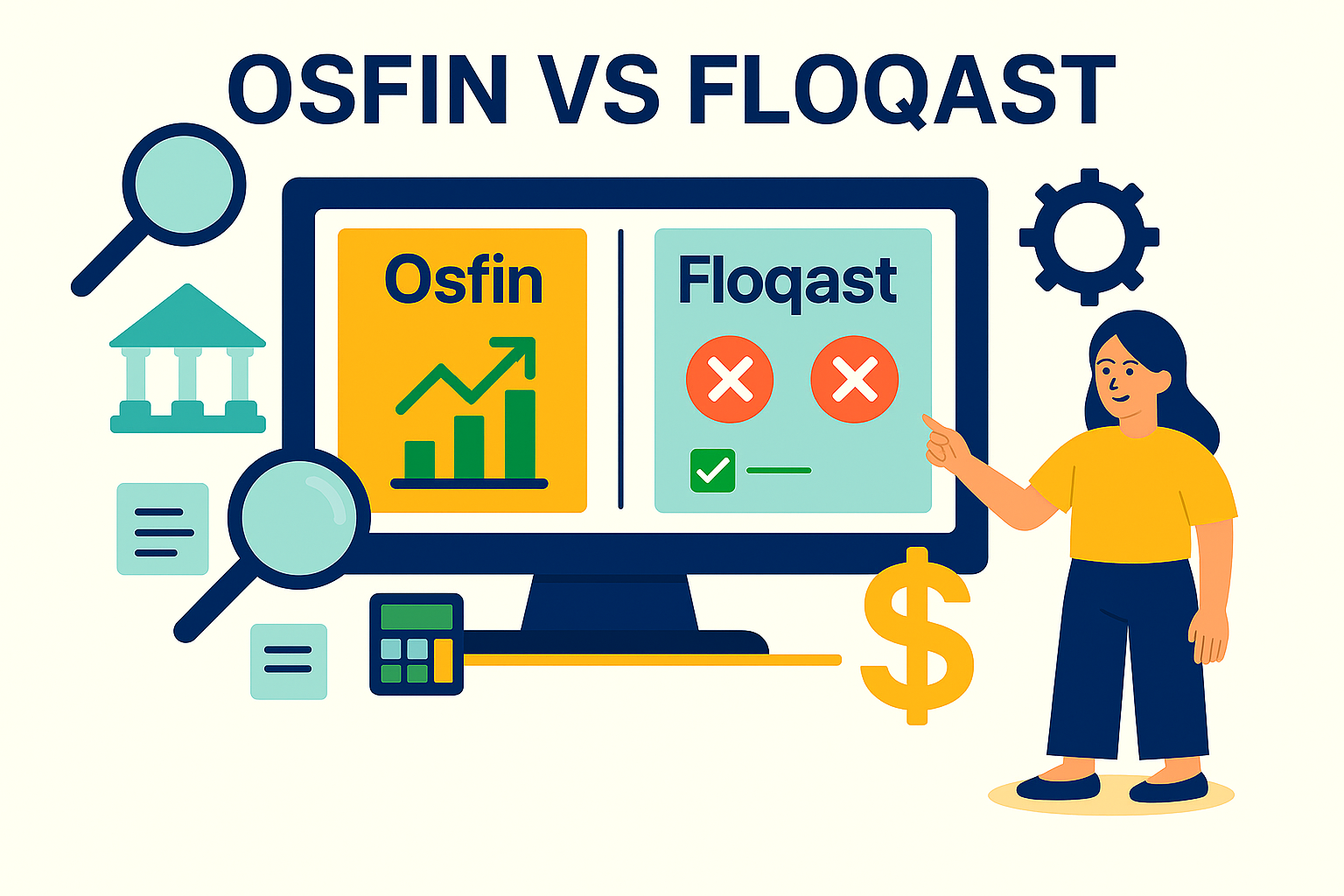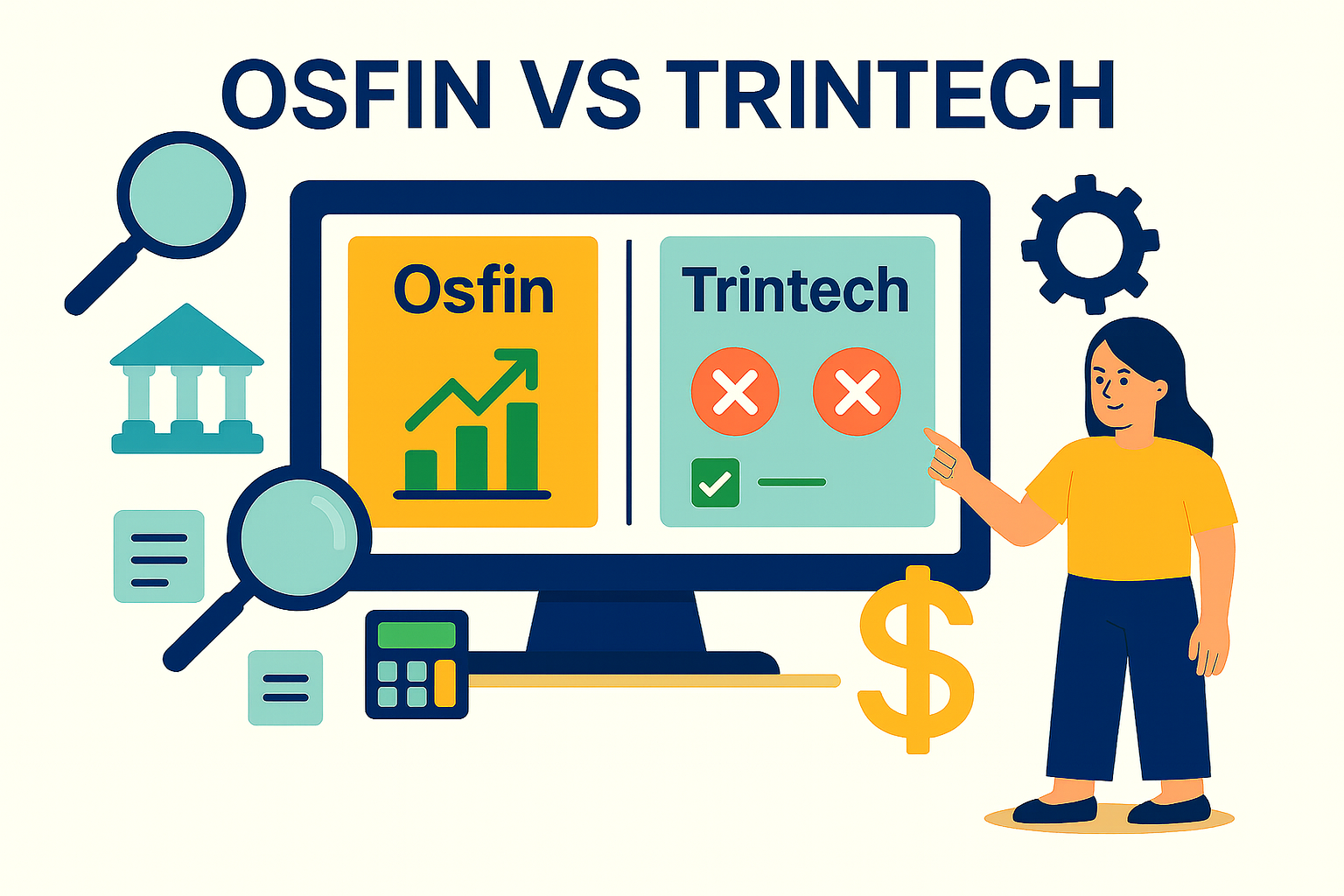ACH vs EFT: Key Differences, Benefits & Use Cases
Electronic payments power nearly every transaction today, and the volume is growing rapidly with the expansion of global commerce and digital banking. The two terms you’ll hear often in this context are EFT and ACH. These are closely related but not the same.
For banks and other financial institutions that initiate, process, route, and reconcile payments across these rails, misunderstanding or mislabelling them can have a significant impact on transaction routing, settlement timing, reconciliation accuracy, and compliance management.
In this article, we explain the differences between ACH and EFT, explore their operational and reconciliation requirements, and show how automation through Osfin.ai can simplify processes, reduce errors, and improve payment accuracy for financial institutions.
What Is EFT? (Electronic Funds Transfer)
Electronic Funds Transfer (EFT) is a common term for moving money between accounts electronically, without using paper instruments like checks or physical cash. EFTs work across different payment systems, each with its own processing speed, cost, and common uses.
Some common types of EFTs include:
1. Wire Transfers: These allow funds to be sent in real time, domestically or internationally, through networks such as SWIFT, Fedwire, or CHIPS. They are ideal for urgent or high-value transactions but usually involve higher processing fees.
2. Card Payments (Credit/Debit): These are transactions carried out via networks like Visa, Mastercard, or RuPay. These are processed within seconds at the point of sale or during online checkout.
3. E-wallet Transfers: This method involves sending or receiving money through platforms such as PayPal, Venmo, or Paytm. These payments are often funded by linked bank accounts or cards and are ultimately settled over existing EFT networks.
4. Real-Time Payment Systems: These enable instant money transfers using domestic platforms like RTP in the United States, UPI in India, or SEPA Instant in the European Union, with funds becoming available to the recipient immediately after the transaction is completed.
What Is ACH? (Automated Clearing House)
The Automated Clearing House (ACH) is one specific EFT network in the United States that processes transactions in batches. It is governed by NACHA and the Federal Reserve, and it connects thousands of banks and credit unions. ACH is primarily used for domestic payments and comes in two forms:
- ACH credits (like payroll deposits) and
- ACH debits (like utility bill collections).
Here’s how an ACH works:
- Initiation: The sender authorizes a payment, either by providing payment details to a business or scheduling a transfer through their bank.
- Submission to Bank: The sender’s bank collects transaction details and groups them into a batch.
- Transmission to ACH Operator: The bank sends the batch to an ACH operator, either the Federal Reserve or The Clearing House.
- Processing and Routing: The ACH operator sorts the transactions by destination and sends them to the receiving banks.
- Settlement: Funds are moved between the banks’ accounts, typically at the end of a processing window.
- Posting to Account: The receiving bank updates the recipient’s account to reflect the payment.
Key Differences: ACH vs Other EFTs
ACH and other EFTs operate on different models. These impact processing speed, settlement timing, fees, and risk management. Here are the major differences between the two methods:
Are EFT and ACH the Same Thing?
Short Answer: No. ACH is one type of Electronic Funds Transfer (EFT), but not all EFTs are ACH payments.
EFT is the overarching term for any transfer of funds made electronically, without using cash or paper checks. It includes many different payment methods, such as wire transfers, card transactions, e-wallet transfers, and real-time payment systems.
ACH, or Automated Clearing House, is one specific EFT network used in the United States to process transactions in batches. It’s mainly used for domestic credits, like payroll deposits, and debits, like bill payments. EFT is an entire category of digital payments, while ACH is one “rail” within it.
Use Cases for ACH vs EFT
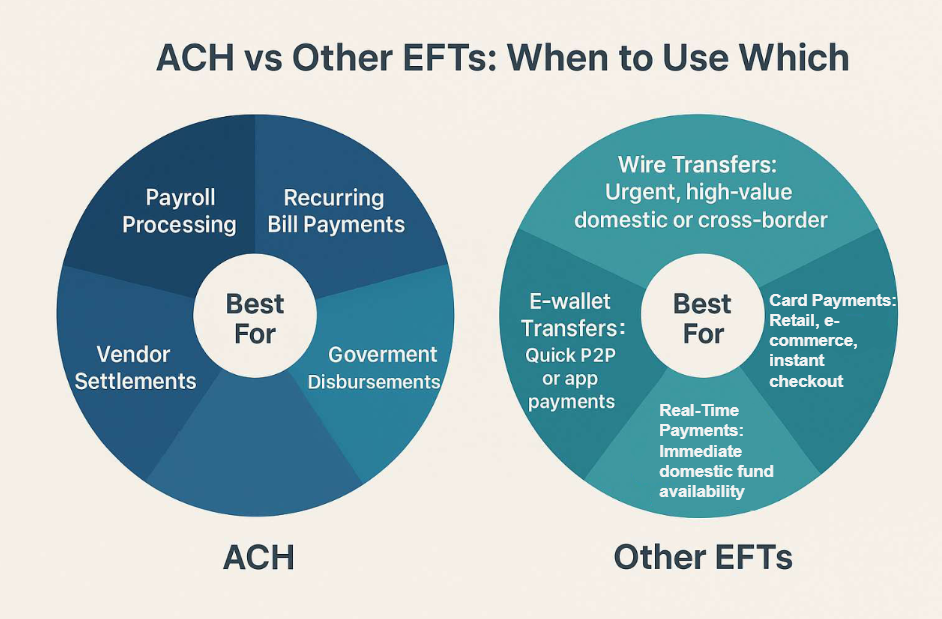
Choosing between ACH and other EFT methods depends on the transaction’s urgency, cost sensitivity, geographic scope, and complexity. Each rail is designed to serve specific needs, and using the right one ensures faster settlement, lower costs, and fewer reconciliation issues.
When to Use ACH
ACH is best for predictable, high-volume domestic transfers where cost efficiency outweighs the need for instant settlement. Some uses include:
- Payroll Processing: Distributing salaries to employees’ accounts on a fixed schedule.
- Recurring Bill Payments: Collecting utility bills, insurance premiums, or subscription fees via automated debits.
- Vendor Settlements: Paying suppliers on regular terms where same-day delivery of funds is not required.
- Government Disbursements: Issuing tax refunds, benefits, or stimulus payments at scale.
When to Choose Other EFTs
With other EFTs, your choice of payment rail would depend on the urgency, value, destination, and nature of the transaction, as well as the level of speed, security, and settlement certainty required.
- Wire Transfers: Urgent, high-value domestic or cross-border payments such as property purchases or corporate treasury movements.
- Card Payments: Retail and e-commerce transactions requiring instant authorization and settlement through card networks.
- E-wallet Transfers: Quick person-to-person or app-based payments.
- Real-Time Payment Systems: Immediate domestic transfers where funds must be available instantly, such as emergency supplier payments.
ACH and EFT in Finance Operations
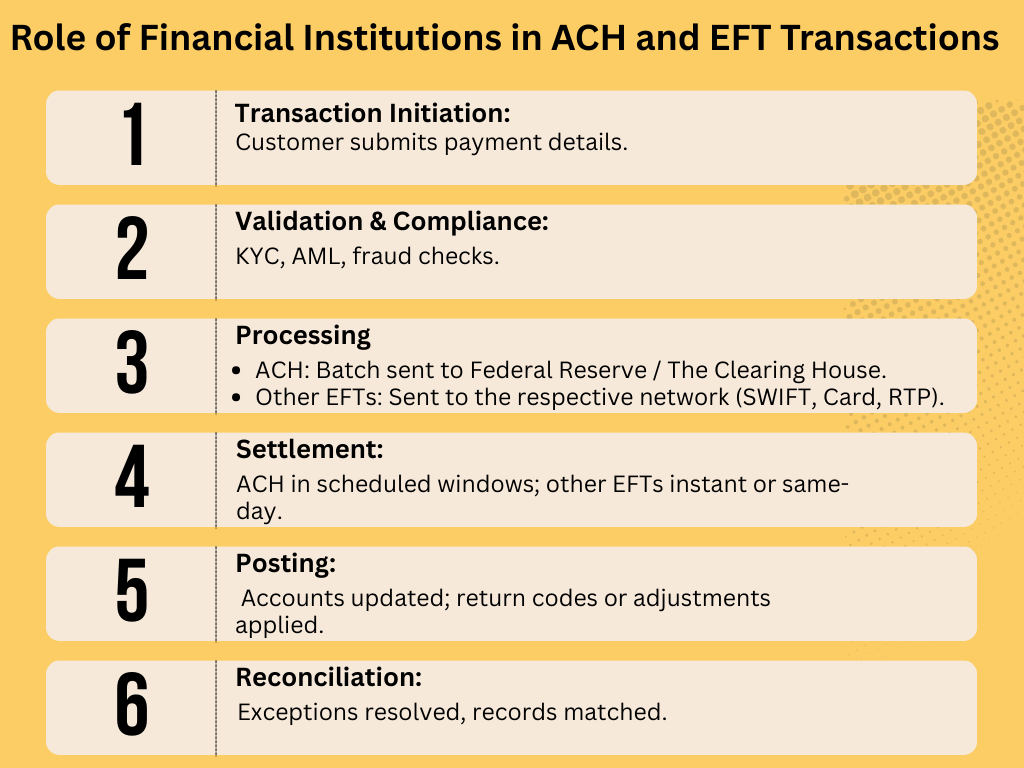
Banks and financial institutions are at the center of both ACH and other EFT transactions, acting as the initiating, processing, and receiving parties. They connect customers to domestic and international payment networks, ensuring money moves securely and efficiently.
For ACH payments, they manage batch submission to operators like the Federal Reserve or The Clearing House, validate transactions, apply return codes when necessary, and post settlements to customer accounts.
With other EFT types such as wires, card payments, and real-time rails, they handle faster or more complex settlement processes, coordinate with multiple intermediaries, and apply fraud screening at different stages.
Why the Difference between ACH vs EFT Matters?
For banks and financial institutions, ACH and other EFT methods may both move money electronically, but the way they operate creates very different demands on internal systems, teams, and controls. Treating them as the same can lead to settlement delays, reconciliation mismatches, and compliance risks.
ACH payments follow a predictable batch schedule, which helps in planning settlement windows and managing processing costs. However, it also means institutions must monitor multiple batch cut-off times, track pending transactions across windows, and manage return codes systematically.
Other EFT types like wires, card payments, and real-time rails introduce entirely different operational pressures. Real-time payments require immediate posting and instant exception resolution, wires demand precise cross-border compliance checks, and card settlements involve multi-party reconciliation with interchange fees and chargebacks.
ACH vs EFT: Payments Reconciliation Perspective
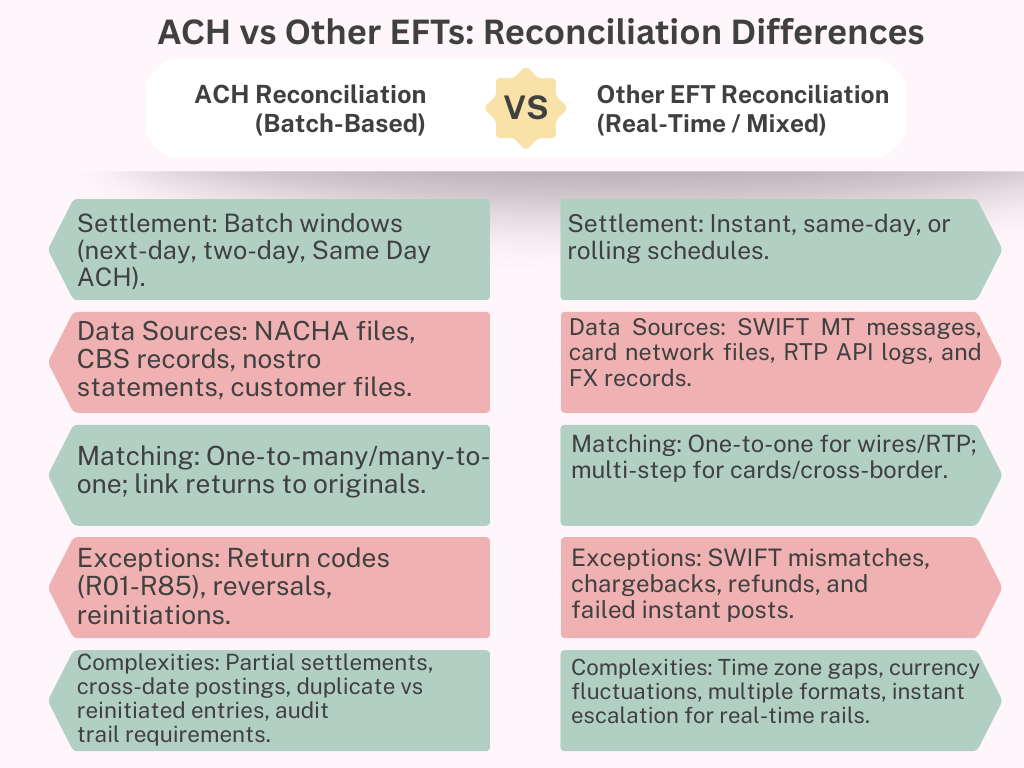
Although ACH is a type of EFT, the reconciliation workflows for ACH and other EFT payment methods differ substantially. The differences stem from processing models (batch vs. real-time), file formats, intermediary involvement, and regulatory requirements.
Reconciliation of ACH Payments
1. Batch-Based Processing and Deferred Settlement
ACH transactions are processed in batch windows (morning, midday, and evening for Same Day ACH; standard ACH with next-day or two-day settlement). This means there can be a gap of hours or days between initiation, settlement, and posting. Reconciliation teams must account for these timing differences to avoid false mismatches.
2. Systems and Data Sources Involved
- NACHA-formatted files from the ACH operator (Federal Reserve or The Clearing House).
- Core Banking System (CBS) records for customer debits and credits.
- Treasury/Nostro account statements showing settlement movements.
- Corporate customer payment files for originations or receivables.
3. Matching Process
In ACH reconciliation, one payment instruction file might result in multiple batch entries (one-to-many), or multiple client-originated instructions might be consolidated into a single settlement entry (many-to-one). Matching logic must also tie return transactions back to their original payments.
4. Exception Handling and Return Codes
ACH has a structured return code system (R01–R85), each indicating a specific reason for failure or reversal. Reconciliation must capture these codes, ensure accurate reversals, and trigger reinitiation processes when applicable. Exceptions may also occur due to incorrect account details, unauthorized debits, or insufficient funds.
5. Complexities in ACH Reconciliation
Some factors that make ACH Reconciliation complex are:
- Partial settlements within a batch.
- Cross-date postings where the settlement date and processing date differ.
- Differentiating between reinitiated transactions and duplicates.
- Maintaining an audit trail for compliance with NACHA rules and federal regulations.
Reconciliation of Other EFT Payments
1. Settlement Models
Unlike ACH, other EFT methods such as wires, card payments, real-time payments (RTP), or cross-border transfers may settle instantly, same-day, or on a rolling schedule depending on the rail. This requires continuous or intraday reconciliation to prevent liquidity and posting issues.
2. Systems and Data Sources Involved
- Wire Transfers: SWIFT MT messages matched against nostro account statements and CBS records.
- Card Payments: Settlement files from card networks (Visa, Mastercard, RuPay) matched with acquirer and merchant accounts, including interchange, fee, and tax breakdowns.
- RTP: API transaction logs and CBS entries matched in near-real time; liquidity positions must be monitored continuously.
- Cross-Border Payments: SWIFT confirmations matched against FX conversion records, intermediary bank charges, and beneficiary account postings.
3. Matching Process
Reconciliation is typically one-to-one for wires and RTP but can be multi-step for card payments and cross-border transfers due to multiple intermediaries. Card payment reconciliation also involves aligning transaction authorizations with settlement amounts, which may vary due to currency conversion or fee deductions.
4. Exception Handling
- Wires: Handling unmatched SWIFT messages, missing MT900/910 confirmations, or delayed intermediary postings.
- Card Payments: Resolving mismatches from chargebacks, refunds, or late presentments.
- RTP: Investigating instant mismatches where the beneficiary account fails to post despite settlement confirmation.
5. Complexities in Other EFT Reconciliation
Some complexities that accompany reconciling other EFT payment rails include:
- Time zone differences in cross-border settlements.
- Currency conversion rate variances between authorization and settlement.
- Multiple data formats require normalization before matching.
- Real-time rails demand instant escalation and resolution processes.
Whether you are handling ACH transactions or managing multiple EFT payment rails, Osfin.ai gives you the speed, accuracy, and control needed to reconcile at scale.
{{banner3.1}}
How Osfin Helps Automate ACH and EFT Reconciliation
Reconciling ACH and other EFT payments at scale involves managing different file formats, matching rules, settlement timelines, and exception types. Manual processes make this slow, error-prone, and costly for banks, credit unions, and fintechs. Osfin.ai automates the entire reconciliation lifecycle, delivering speed, accuracy, and compliance without adding operational burden.
Comprehensive File and Format Support
- Ingests data from numerous sources related to ACH and EFT payment rails through over 170+ pre-built integrations. This facilitates easy multi-system aggregation.
- Osfin.ai is a format-agnostic platform and easily handles file formats like XSL, CSV, TSV, JSON, and more. It automatically parses them and applies custom deviation tolerances to filter out poor quality data before reconciliation.
High-Speed, Accurate Matching
- Matches up to 30 million records in 15 minutes with 100% accuracy.
- Uses automated matching logic AND supports one-to-one, one-to-many, and many-to-one scenarios across ACH batches, wire transfers, card settlements, RTP transactions, and cross-border EFTs.
Intelligent Exception Management and Routing
- Real-time exception tagging for ACH return codes, unmatched wire confirmations, RTP posting failures, and card chargeback discrepancies.
- Flags and tags matched transactions with accurate reasons.
- The ticketing and exception handling engine automatically creates tickets and sends exceptions to the right team instantly, greatly reducing resolution times.
Real-Time Visibility and Control
- Interactive dashboards for tracking ACH batch statuses, EFT settlements, outstanding exceptions, and resolutions.
- Helps you spot anomalies quickly before they become large-scale issues.
Security and Compliance
- 256-bit SSL encryption, VAPT-tested platform.
- Offers role-based access controls with two-factor authentication to safeguard sensitive payment data.
- Compliance with SOC 2, ISO 27001, PCI DSS, and GDPR requirements.
Operational Efficiency and Audit-Readiness
- Complete audit-ready workflows with logs, traceable history, and timestamped records for regulatory reviews.
- Fast implementation with minimal disruption to existing payment operations.
- A full-fledged support team and documentation to help you set up and integrate with your existing tech stack.
By automating EFT reconciliation and ACH reconciliation, Osfin.ai allows financial institutions to process higher volumes with unmatched accuracy, eliminate manual bottlenecks, reduce settlement risks, and deliver a smoother experience for corporate and retail clients alike.
{{banner1.1}}
FAQs on ACH vs EFT
1. Is electronic funds transfer the same as ACH?
No. Electronic Funds Transfer (EFT) is a broad term used for nearly all digital money movements, while ACH is one specific EFT network in the US. ACH processes batch transactions, whereas other EFT types include wires, card payments, and real-time payment systems.
2. What is an example of an EFT payment?
A common example of an EFT payment is a wire transfer. In this method, funds are electronically sent from one bank account to another, often across borders, using networks like SWIFT or Fedwire, without the need for paper checks or cash.
3. What is the equivalent of ACH in other countries?
Other countries operate similar batch clearing systems with their own processing rules, settlement times and compliance standards. Some examples include BACS in the UK, BECS in Australia, EFT in Canada, and SEPA Credit Transfer in the European Union.
4. How long does ACH settlement take compared to wires?
Standard ACH settlement typically takes one to two business days, with Same Day ACH available for faster processing. Wire transfers, in contrast, settle on the same business day, often within hours, making them faster but usually more expensive to process.
5. What reconciliation challenges are unique to ACH payments?
ACH reconciliation must address batch processing complexities, including handling return codes, settlement delays, and partial failures. Banks must match large volumes of transactions across NACHA files and internal ledgers while managing reinitiations, reversals, and timing mismatches in posted credits and debits.
